REPRODUCTIVE SYSTEM
Reproduction in Plants
There are three types of reproduction in plants namely i) Vegetative ii) Asexual and iii) Sexual reproduction.
Vegetative Reproduction:
In this type, new plantlets are formed from vegetative (somatic) cells, buds or organs of plant. The vegetative part of plant (root, stem, leaf or bud) gets detached from the parent body and grows into an independent daughter plant. It has only mitotic division, no gametic fusion and daughter plants are genetically similar to the parent plant.
Vegetative reproduction may take place through
- Leaves: In Bryophyllum small plants grow at the leaf notches
- Stems: In strawberry aerial weak stems touch the ground and give off adventitious roots and buds. When the connections with the parent plant is broken, the offspring beomes independent.
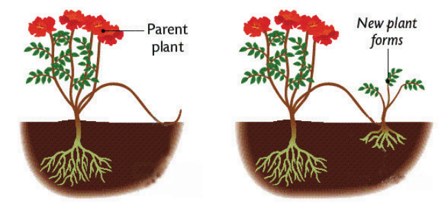
- Root: Tuberous roots (Asparagus and Sweet potato) can be used for vegetative propagation.
- Bulbils: In some plants the flower buds modified into globose which are called as bulbils. When these falls on the ground they grow into new plants. e.g. Agave.
- Other types of Vegetative Reproduction
- Fragmentation: In filamentous algae, breaking of the filament into many fragments is called fragmentation. Each fragment having atleast one cell, may give rise to a new filament of the algae by cell division e.g. Spirogyra.
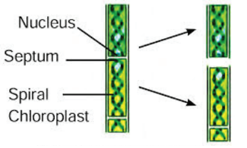
- Fission: In this type the parent cell divides into two daughter cells and each cell develops into a new adult organism e.g. Amoeba.
- Budding: Formation of a daughter individual from a small projection, the bud, arising on the parent body is called budding. e.g. Yeast.
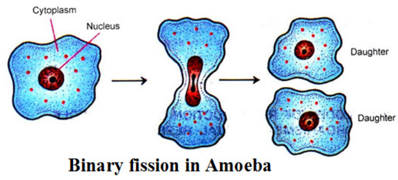
- Regeneration: The ability of the lost body parts of an individual organism to give rise to an whole new organism is called regeneration. It takes place by specialized mass of cells e.g Hydra and Planaria.
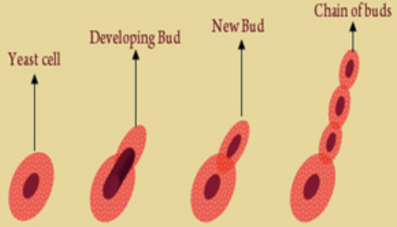
Asexual Reproduction:
Production of an offspring by a single parent without the formation and fusion of gametes is called asexual reproduction. It involves only mitotic cell divisions and meiosis does not occur. Offspring produced by asexual reproduction are not only identical to parents but are also exact copies of their parent.
Asexual reproduction occurs by spore formation. This is the most common method of asexual reproduction in fungi and bacteria.
During spore formation a structure called sporangium develops from the fungal hypha. The nucleus divides several times within the sporangium and each nucleus with small amount of cytoplasm develops into a spore. The spores are liberated and they develop into new hypha after reaching the ground or substratum.
Pollination:
The transfer of pollen grains from anther to stigma of a flower is called as pollination
Importance of Pollination
- It results in fertilization which leads to the formation of fruits and seed.
- New varieties of plants are formed through new combination of genes in case of cross pollination.
Types of Pollination
- Self-pollination (Autogamy)
Self-pollination is also known as autogamy. The transfer of pollen grains from the anther to the stigma of same flower or another flower borne on the same plant is known as selfpollination. e.g. Hibiscus
Advantages of self-pollination
- Self-pollination is possible in bisexual flowers.
- Flowers do not depend on agents for pollination.
- There is no wastage of pollen grains.
Disadvantages of self-pollination
- The seeds are less in numbers.
- The endosperm is minute. Therefore, the seeds produce weak plants.
- New varieties of plants cannot be produced
- Cross pollination
Cross-pollination is the transfer of pollen from the anthers of a flower to the stigma of a flower on another plant of the same species e.g. apples, grapes, plum, etc.
Advantages of cross pollination
- The seeds produced as a result of cross pollination, develop and germinate properly and grow into better plants, i.e. cross pollination leads to the production of new varieties.
- More viable seeds are produced.
Disadvantages of cross-pollination
- Pollination may fail due to distance barrier.
- More wastage of pollen grains
- It may introduce some unwanted characters
- Flowers depend on the external agencies for pollination
Agents of Cross Pollination:
In order to bring about cross pollination, it is necessary that the pollen should be carried from one flower to another of a different plant. This takes place through the agency of animals, insects, wind and water.
- Pollination by wind
The pollination with the help of wind is called anemophily. The anemophilous flowers produce enormous amount of pollen grains. The pollen grains are small, smooth, dry and light in weight. Pollen of such plants are blown off at a distance of more than 1,000 km. The stigmas are comparatively large, protruding and sometimes hairy to trap the pollen grains. e.g. Grasses and some cacti.
- Pollination by insects
Pollination with the help of insects like honey bees, flies are called entomophily. To attract insects these flowers are brightly coloured, have smell and nectar. The pollen grains are larger in size, the exine is pitted, spiny etc., so they can be adhered firmly on the sticky stigma. Approximately, 80% of the pollination done by the insects is carried by honey bees.
- Pollination by water
The pollination with the help of water is called hydrophily.This takes place in aquatic plants.
Pollen grains are produced in large numbers.
Pollen grains float on surface of water till they land on the stigma of female flowers e.g. Hydrilla, Vallisneria.
- Pollination by Animals
When pollination takes place with the help of animals, it is called Zoophily. Flowers of such plants attract animals by their bright color, size, scent etc. e.g. sun bird pollinates flowers of Canna, Gladioli etc., Squirrels pollinate flowers of silk cotton tree.
Male Reproductive System:
Human male reproductive system consists of testes (primary sex organs), scrotum, vas deferens, urethra, penis and accessory glands. Testes: A pair of testes lies outside the abdominal cavity of the male. These testes are the male gonads, which produce male gametes (sperms) and male sex hormone (Testosterone). Along the inner side of each testis lies a mass of coiled tubules called epididymis. The Sertoli cells of the testes provide nourishment to the developing sperms.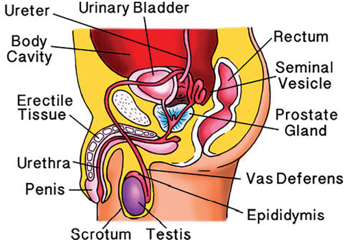
Scrotum: The scrotum is a loose pouch-like sac of skin which is divided internally into right and left scrotal sacs by muscular partition. The two testes lie in the respective scrotal sacs. It also contains many nerves and blood vessels. The scrotum acts as a thermoregulator organ and provides an optimum temperature for the formation of sperms. The sperms develop at a temperature of 1-3⁰C lower than the normal body temperature.
Vas deferens: It is a straight tube which carries the sperms to the seminal vesicles. The sperms are stored in the seminal plasma of seminal vesicle, which is rich in fructose, calcium and enzymes. Fructose is a source of energy for the sperm. The vas deferens along with seminal vesicles opens into ejaculatory duct which expels the sperm and its secretions from seminal vesicles into the urethra.
Urethra: It is contained inside the penis and conveys the sperms from the vas deferens which pass through the urethral opening. The accessory glands associated with the male reproductive system consist of seminal vesicles, prostate gland and Cowper’s glands. The secretions of these glands form seminal fluid and mixes with the sperm to form semen. This fluid provides nutrition and helps in the transport of sperms.
Female Reproductive System:
The female reproductive system consists of ovaries (primary sex organs), oviducts, uterus and vagina.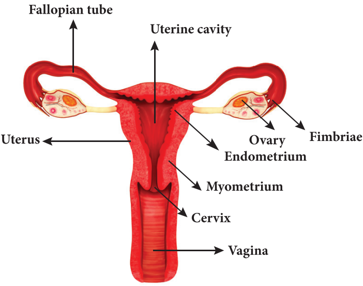
Ovaries: A pair of almond-shaped ovaries is located in the lower part of abdominal cavity near the kidneys in female. The ovaries are the female gonads, which produce female gametes (eggs or ova) and secrete female sex hormones (Oestrogen and Progesterone).A mature ovary contains a large number of ova in different stages of development.
Fallopian tubes (Oviducts): These are paired tubes originating from uterus, one on either side. The terminal part of fallopian tube is funnel-shaped with finger-like projections called fimbriae lying near the ovary. The fimbriae pick up the ovum released from ovary and push it into the fallopian tube.
Uterus: Uterus is a pear-shaped muscular, hollow structure present in the pelvic cavity. It lies between urinary bladder and rectum. Development of foetus occurs inside the uterus. The narrower lower part of uterus is called cervix, which leads into vagina.
Vagina: The uterus narrows down into a hollow muscular tube called vagina. It connects cervix and the external genitalia. It receives the sperms, acts as birth canal during child birth (parturition).
Sexual Reproduction in Human:
New individuals develop by the fusion of gametes. Sexual reproduction involves the fusion of two haploid gametes (male and the female gametes) to form a diploid individual (zygote).
Primary reproductive organs include the gonads (Testes in male and Ovaries in female Accessory sex organs
Male: Vas deferens, epididymis, seminal vesicle, prostate gland and penis.
Female: Fallopian tubes, uterus, cervix and vagina.
The secondary (accessory) sex organs include those structures which are involved in the
- Process of ovulation
- Fusion of the male and female gametes (fertilization)
- Division of the fertilized egg upto the formation of embryo
- Pregnancy
- Development of foetus
- Child birth.
Male Reproductive Organ – Structure of Testes:
Testes are the reproductive glands of the male that are oval shaped organs which lie outside the abdominal cavity of a man in a sac like structure called scrotum. Now we shall study the various cells which are present in the testes.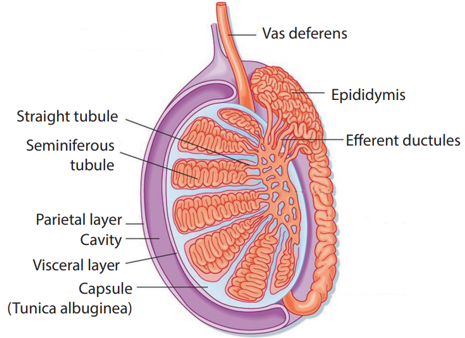
Each testes is covered with a layer of fibrous tissue called tunica albuginea. Many septa from this layer divide the testes into pyramidal lobules, in which lie seminiferous tubules, cells of Sertoli, and the Leydig cells (interstitial cells).
The process of spermatogenesis takes place in the seminiferous tubules. The Sertoli cells are the supporting cells and provide nutrients to the developing sperms. The Leydig cells are polyhedral in shape and lie between the seminiferous tubules and secrete testosterone. It initiates the process of spermatogenesis.
Female Reproductive Organ – Structure of Ovary:
The ovaries are located on either side of the lower abdomen composed of two almond shaped bodies, each lying near the lateral end of fallopian tube. Each ovary is a compact structure consisting of an outer cortex and an inner medulla. The cortex is composed of a network of connective tissue called as stroma and is lined by the germinal epithelium. The epithelial cells called the granulosa cells surround each ovum in the ovary together forming the primary follicle. As the egg grows larger, the follicle also enlarges and gets filled with the fluid and is called the Graafian follicle.
Gametogenesis
The formation of the sperm in male and the ovum in female is called gametogenesis. It involves spermatogenesis (formation of spermatozoa) and oogenesis (the formation of ova). Gametes with haploid cells are produced through gametogenesis.
Gametogenesis:
Gametogenesis is the process of formation of gametes i.e., sperms and ovary from the primary sex organs in all sexually reproducing organisms. Meiosis plays the most significant role in the process of gametogenesis.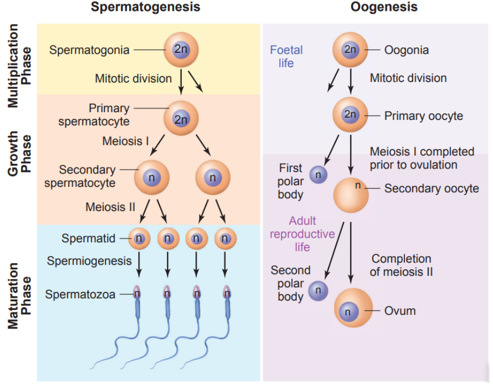
Spermatogenesis is the sequence of events in the seminiferous tubules of the testes that produce the male gametes, the sperms. During development, the primordial germ cells migrate into the testes and become immature germ cells called sperm mother cells or spermatogonia in the inner surfaces of the seminiferous tubules. The spermatogonia begin to undergo mitotic division at puberty and continue throughout life.
In the first stage of spermatogenesis, the spermatogonia migrate among sertoli cells towards the central lumen of the seminiferous tubule and become modified and enlarged to form primary spermatocytes which are diploid with 23 pairs i.e., 46 chromosomes.
Some of the primary spermatocytes undergo first meiotic division to form two secondary spermatocytes which are haploid with 23 chromosomes each. The secondary spermatocytes undergo second meiotic division to produce four haploid spermatids. The spermatids are transformed into mature spermatozoa (sperms) by the process called spermiogenesis. Sperms are finally released into the cavity of seminiferous tubules by a process called spermiation. The whole process of spermatogenesis takes about 64 days. At any given time, different regions of the seminiferous tubules contain spermatocytes in different stages of development. The sperm production remains nearly constant at a rate of about 200 million sperms per day.
Spermatogenesis starts at the age of puberty and is initiated due to the increase in the release of Gonadotropin Releasing Hormone (GnRH) by the hypothalamus. GnRH acts on the anterior pituitary gland and stimulates the secretion of two gonadotropins namely Follicle Stimulating Hormone (FSH) and Lutenizing Hormone (LH). FSH stimulates testicular growth and enhances the production of Androgen Binding Protein (ABP) by the sertoli cells and helps in the process of spermiogenesis. LH acts on the Leydig cells and stimulates the synthesis of testosterone which in turn stimulates the process of spermatogenesis.
Oogenesis
Oogenesis is the process of development of the female gamete or ovum or egg in the ovaries. During foetal development, certain cells in the germinal epithelium of the foetal ovary divide by mitosis and produce millions of egg mother cells or oogonia. No more oogonia are formed or added after birth. The oogonial cells start dividing and enter into Prophase I of meiotic division I to form the primary oocytes which are temporarily arrested at this stage. The primary oocytes then get surrounded by a single layer of granulosa cells to form the primordial or primary follicles. A large number of follicles degenerate during the period from birth to puberty, so at puberty only 60,000 to 80,000 follicles are left in each ovary.
The primary follicle gets surrounded by many layers of granulosa cells and a new theca layer to form the secondary follicle. A fluid filled space, the antrum develops in the follicle and gets transformed into a tertiary follicle. The theca layer gets organized into an inner theca interna and an outer theca externa. At this time, the primary oocyte within the tertiary follicle grows in size and completes its first meiotic division and forms the secondary oocyte. It is an unequal division resulting in the formation of a large haploid secondary oocyte and a first polar body. The first polar body disintegrates. During Fertilization, the secondary oocyte undergoes second meiotic division and produces a large cell, the ovum and a second polar body. The second polar body also degenerates. The tertiary follicle eventually becomes a mature follicle or Graafian follicle. If Fertilization does not take place, second meiotic division is never completed and the egg disintegrates. At the end of gametogenesis in females, each primary oocyte gives rise to only one haploid ovum.
Twins:
Sometimes ovaries releases two eggs and each is fertilised by a different sperm, resulting in Non-Identical Twins (Fraternal Twins). If single egg is fertilised and then divides into two foetus, Identical Twins develop.
Twins are two offsprings produced in the same pregnancy.
- Monozygotic (Identical) twins are produced when a single fertilised egg splits into two during the first cleavage. They are of the same sex, look alike and share the same genes.
- Dizygotic (Fraternal) twins are produced when two separate eggs are fertilised by two separate sperms. The twins may be of the same sex or different sex and are non-identical.
- Siamese (United) twins are the conjoined twins who are joined during birth.
Infertility:
Inability to conceive or produce children even after unprotected sexual cohabitation is called infertility. That is, the inability of a man to produce sufficient numbers or quality of sperm to impregnate a woman or inability of a woman to become pregnant or maintain a pregnancy.
The causes for infertility are tumours formed in the pituitary or reproductive organs, inherited mutations of genes responsible for the biosynthesis of sex hormones, malformation of the cervix or fallopian tubes and inadequate nutrition before adulthood. Long-term stress damages many aspects of health especially the menstrual cycle. Ingestion of toxins (heavy metal cadmium), heavy use of alcohol, tobacco and marijuana, injuries to the gonads and aging also cause infertility.
Other causes of infertility
- Pelvic inflammatory disease (PID), uterine fibroids and endometriosis are the most common causes of infertility in women.
- Low body fat or anorexia in women. i.e. a psychiatric eating disorder characterised by the fear of gaining weight.
- Undescended testes and swollen veins (varicocoele) in scrotum.
- Tight clothing in men may raise the temperature in the scrotum and affect sperm production.
- Under developed ovaries or testes.
- Female may develop antibodies against her partner’s sperm.
- Males may develop an autoimmune response to their own sperm.
Assisted reproductive technology (ART):
A collection of procedures, which includes the handling of gametes and/or embryos outside the body to achieve a pregnancy, is known as Assisted Reproductive Technology. It increases the chance of pregnancy in infertile couples. ART includes intra-uterine insemination (IUI), in vitro fertilization, (IVF) Embryo transfer (ET), Zygote intra-fallopian transfer (ZIFT), Gamete intrafallopian transfer(GIFT), Intra-cytoplasmic sperm injection(ICSI), Preimplantation genetic diagnosis, oocyte and sperm donation and surrogacy.
- Intra-uterine insemination (IUI)
This is a procedure to treat infertile men with low sperm count. The semen is collected either from the husband or from a healthy donor and is introduced into the uterus through the vagina by a catheter after stimulating the ovaries to produce more ova. The sperms swim towards the fallopian tubes to fertilize the egg, resulting in normal pregnancy.
- In vitro fertilization (IVF) or Test tube baby
In this technique, sperm and eggs are allowed to unite outside the body in a laboratory. One or more fertilized eggs may be transferred into the woman’s uterus, where they may implant in the uterine lining and develop. Excess embryos may be cryopreserved (frozen) for future use. Initially, IVF was used to treat women with blocked, damaged, or absent fallopian tubes. Today, IVF is used to treat many causes of infertility. The basic steps in an IVF treatment cycle are ovarian stimulation, egg retrieval, fertilization, embryo culture, and embryo transfer.
Egg retrieval is done by minor surgery under general anesthesia, using ultrasound guide after 34 to 37 hours of hCG (human chorionic gonadotropin) injection. The eggs are prepared and stripped from the surrounding cells. At the same time, sperm preparation is done using a special media. After preparing the sperms, the eggs are brought together. 10,000-1,00,000 motile sperms are needed for each egg. Then the zygote is allowed to divide to form 8 celled blastomere and then transferred into the uterus for a successful pregnancy. The transfer of an embryo with more than 8 blastomeres stage into uterus is called Embryo transfer technique.
- Zygote intra-fallopian transfer (ZIFT)
As in IVF, the zygote upto 8 blastomere stage is transferred to the fallopian tube by laparoscopy. The zygote continues its natural divisions and migrates towards the uterus where it gets implanted.
- Intra uterine transfer (IUT)
Embryo with more than 8 blastomeres is inserted into uterus to complete its further development.
- Gamete intra-fallopian transfer (GIFT)
Transfer of an ovum collected from a donor into the fallopian tube. In this the eggs are collected from the ovaries and placed with the sperms in one of the fallopian tubes. The zygote travels toward the uterus and gets implanted in the inner lining of the uterus.
- Intra-cytoplasmic sperm injection (ICSI)
In this method only one sperm is injected into the focal point of the egg to fertilize. The sperm is carefully injected into the cytoplasm of the egg. Fertilization occurs in 75 – 85% of eggs injected with the sperms. The zygote is allowed to divide to form an 8 celled blastomere and then transferred to the uterus to develop a protective pregnancy.
- Surrogacy
Surrogacy is a method of assisted reproduction or agreement whereby a woman agrees to carry a pregnancy for another person, who will become the newborn child’s parent after birth. Through in vitro fertilization (IVF), embryos are created in a lab and are transferred into the surrogate mother’s uterus.
- Male infertility prevention
Azoospermia is defined as the absence of spermatozoa in the ejaculate semen on at least two occasions and is observed approximately in 1% of the population.
- Micro-testicular sperm extraction (TESE)
Microsurgical sperm retrieval from the testicle involves a small midline incision in the scrotum, through which one or both testicles can be seen. Under the microscope, the seminiferous tubules are dilated and small amount of testicular tissue in areas of active sperm production are removed and improved for sperm yield compared to traditional biopsy techniques.
